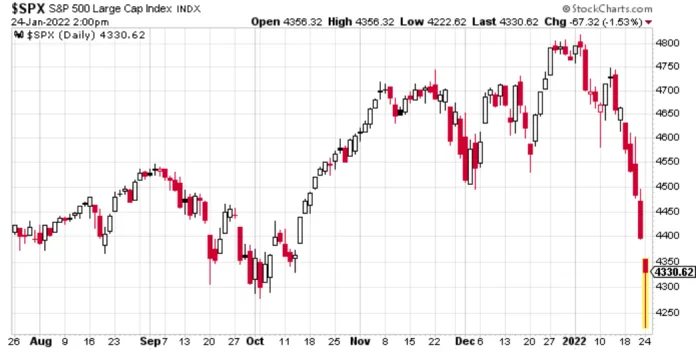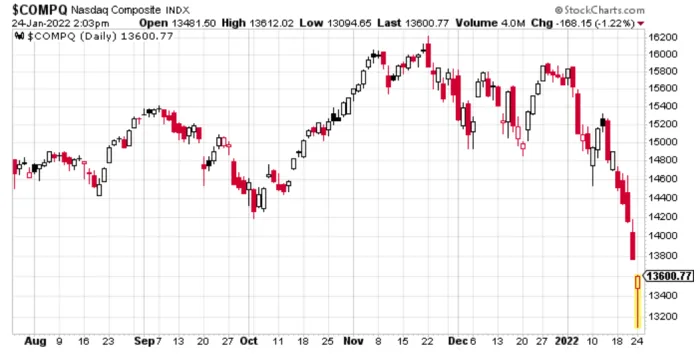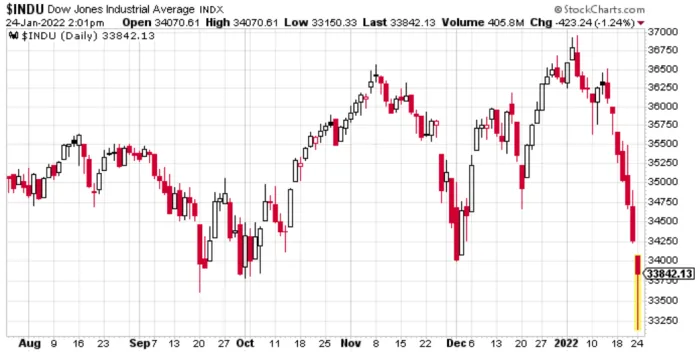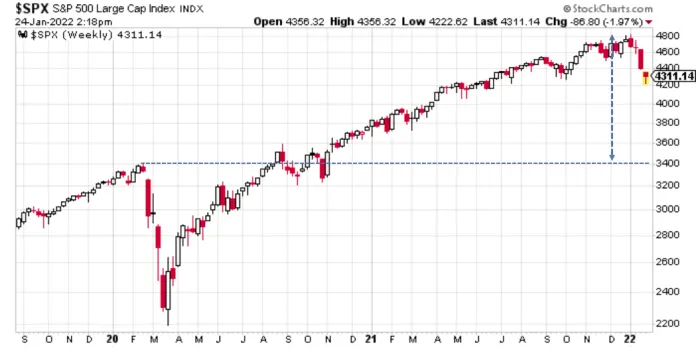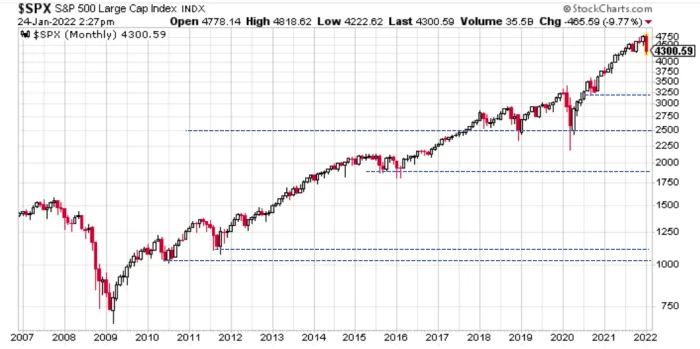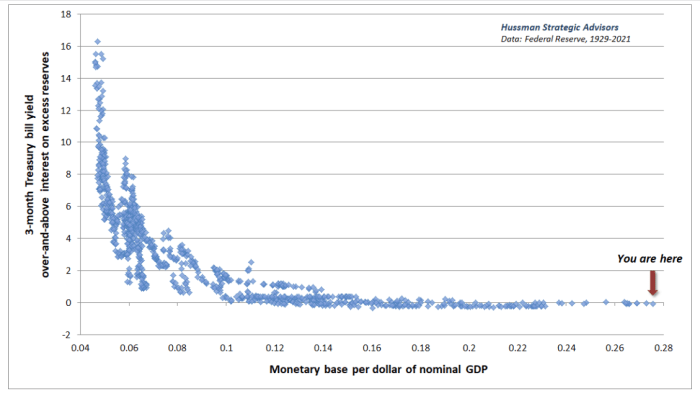The Dow fell over 800 points and the Nasdaq fell 4% intraday with all the major indexes down at least 10% from their highs.
S&P 500 chart courtesy of Stockcharts.com.
All of the major indexes were hammered today but have recovered some of their losses as of 1:00 PM Central.
As I type now, at 1:50 Central stocks reversed lower.
Nasdaq Composite Index
Nasdaq Composite Index courtesy of Stockcharts.com.
The DOW
Dow Jones Industrial Index courtesy of Stockcharts.com.
There is now a vicious short covering rally underway and stocks closing green would not surprise me in the least.
Nor should anyone be surprised if stocks reverse back towards the lows.
Let's step back and look at longer term charts and the grand scheme of things.
S&P 500 Weekly
S&P 500 Weekly Chart courtesy of Stockcharts.com, annotated by Mish
A weekly chart shows stocks more than doubled from the pandemic low.
It would take another 900 point plunge on the S&P 500 just to get back to the pre-pandemic high.
Let's take an even broader view.
S&P 500 Monthly Chart
S&P 500 Monthly Chart courtesy of Stockcharts.com, annotated by Mish
The dashed lines show technical support levels.
Many millennials and Zoomers have no idea what a strong bear market feels like.
I believe we are headed for one courtesy of the Fed's cheap money coupled with three rounds of fiscal stimulus, one under president Trump and two under Biden.
Yep, I have been a bear for a long time. But the Fed had other ideas pumping massive amounts of QE and holding rates too low too long just as it did the 2000 dotcom bubble followed by the 2007 housing bubble.
By every measure, this bubble is bigger and more encompassing than the previous two.
A 40% decline from the tops is the bare minimum of what I expect. That's how insanely overvalued stocks are.
If so, this plunge from the January highs is barely a down pay on what's coming.
John Hussman has an excellent column this month called Return-Free Risk that I encourage everyone to read.
The question isn’t whether one should adapt to unprecedented Fed policies, but instead, the form those adaptations should take. We are fully convinced that these historic valuation extremes have removed decades of investment returns from the future, and strongly suspect that the Fed has amplified future downside risk as well. I believe investors have placed themselves in a position that is likely to be rewarded by a very long, interesting trip to nowhere over the coming 10-20 years. At worst, they may discover the hard way that a retreat merely to historically run-of-the-mill valuations really does imply a two-thirds loss in the S&P 500.
A Fed-Induced Speculative Bubble
The chart below shows how deranged Federal Reserve policy has become. I use that word advisedly: de-ranged as in wildly outside of historical bounds, and also deranged as in intellectually unsound. The most important issue facing the Fed here isn’t how quickly to taper its asset purchases, or when the next rate hike should occur. The real problem for the Fed is that it has completely abandoned any semblance to a systematic policy framework, in apparent preference for a purely discretionary one.
Monetary Base Per Dollar of Nominal GDP
Monetary Base Per Dollar of Nominal GDP - Chart from HussmanFunds.Com
The current level of the monetary base relative to GDP is utterly at odds with Section 2A of the Federal Reserve Act, which instructs the Fed to “maintain long-run growth of the monetary and credit aggregates commensurate with the economy’s long run potential to increase production.” The ratio of base money to GDP never exceeded 16% before 2008. The nearest alternative to holding zero-interest base money is to hold a Treasury bill, and 16% of GDP in zero interest base money is already sufficient to drive T-bill rates to zero. Until the Federal Reserve contracts its balance sheet by half, the only way the Fed can raise short term interest rates above zero is by explicitly paying interest to banks on their excess reserves (IOER).
In case you missed it, also see my January 21 post S&P 500 Futures Positioning Suggests More Down is Coming.
Well, here we are.
Despite the selloff, fund managers and speculators are still hugely long futures, even adding more.
Hussman is accused of being a perma-bear and so am I. What's true is that we seek to above bubbles and this one has been spectacular.
Yet, my 40% decline scenario (at least) make me look like a raging optimist compared to John.
Thanks for Tuning In!
This material is based upon information that Sitka Pacific Capital Management considers reliable and endeavors to keep current, Sitka Pacific Capital Management does not assure that this material is accurate, current or complete, and it should not be relied upon as such.
Recommended Content
Editors’ Picks

EUR/USD consolidates weekly gains above 1.1150
EUR/USD moves up and down in a narrow channel slightly above 1.1150 on Friday. In the absence of high-tier macroeconomic data releases, comments from central bank officials and the risk mood could drive the pair's action heading into the weekend.

GBP/USD stabilizes near 1.3300, looks to post strong weekly gains
GBP/USD trades modestly higher on the day near 1.3300, supported by the upbeat UK Retail Sales data for August. The pair remains on track to end the week, which featured Fed and BoE policy decisions, with strong gains.

Gold hits new highs on expectations of global cuts to interest rates
Gold (XAU/USD) breaks to a new record high near $2,610 on Friday on heightened expectations that global central banks will follow the Federal Reserve (Fed) in easing policy and slashing interest rates.

Pepe price forecast: Eyes for 30% rally
Pepe’s price broke and closed above the descending trendline on Thursday, eyeing for a rally. On-chain data hints at a bullish move as PEPE’s dormant wallets are active, and the long-to-short ratio is above one.

Bank of Japan set to keep rates on hold after July’s hike shocked markets
The Bank of Japan is expected to keep its short-term interest rate target between 0.15% and 0.25% on Friday, following the conclusion of its two-day monetary policy review. The decision is set to be announced during the early Asian session.

Moneta Markets review 2024: All you need to know
VERIFIED In this review, the FXStreet team provides an independent and thorough analysis based on direct testing and real experiences with Moneta Markets – an excellent broker for novice to intermediate forex traders who want to broaden their knowledge base.
